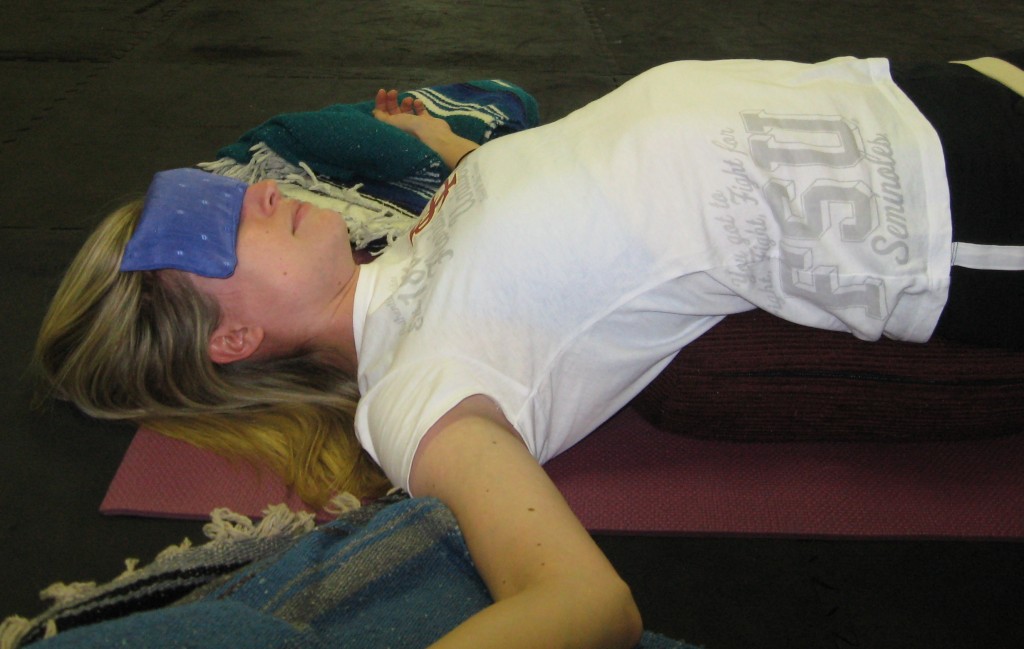The Bridge of Support
Most asana is active. But there is this deliciously sweet (and way better for you than those holiday goodies) subset of poses called restorative yoga. Instead of doing, these are poses of being. Restorative yoga teaches us how to relax deeply and completely.
Judith Lasater, who literally wrote the book on Restorative yoga says, “During deep relaxation, all the organ systems of the body are benefited, and a few of
the measurable results of deep relaxation are the reduction of blood pressure, serum triglycerides and blood sugar levels in the blood, the increase of the ‘good cholesterol’ levels, as well as improvement in digestion, fertility, elimination, the reduction of muscle tension, insomnia and generalized fatigue.”
Who doesn’t need something on that list?! During this busy Holiday month it is so important we take the time to relax deeply. So, each week I’ll be featuring a different restorative pose. Try practicing one of them every day at the end of your regular asana practice.
This week’s pose is supported bridge pose. Much like its active counterpart, Setu Bandha Sarvangasana (Bridge Pose), it quiets the mind. But, the props allow you to linger longer and release more deeply.
The Set-Up
This may seem like a lot of props, but they are instrumental in encouraging your body to surrender to relaxation.
Here’s what you need:
- Yoga mat
- 1 or 2 bolsters (2 firm blankets, folded in half lengthwise, can be substituted for the second bolster, if needed)
- 1 eye bag
- 1 – 2 straps, optional
- 10 lb. sandbag (strap can be used in lieu of the sandbag)
- 3-5 blankets in the traditional fold (Judith Lasater calls this “Tadasana” for the blanket) as pictured here:
Place your bolsters (or bolster and folded blankets) end to end on your mat. If you are using the straps, place one strap under the top bolster and the other strap under the lower bolster.
Fold two blankets nearly in half, leaving them stair-stacked, as pictured below. Place one on each side of your mat.
Place the last blanket, the sandbag and the eye bag beside your mat.
In the Pose
Sit about halfway down the upper bolster with your knees bent and your feet on either side of the props. Keeping the knees bent, lay back on the props. Your head and shoulders should rest comfortably on the floor, as pictured below.
If this feels like too deep of a backbend, roll to the side and sit up. Then, substitute two blankets, folded lengthwise, end-to-end for the bolsters. Repeat the above process to enter the backbend.
Experiment with lengthening your legs along the props. If this causes discomfort in the low back, keep the knees bent.
The two straps (one at the hip creases and one at lower legs) can be used to anchor you to the props. A sandbag placed on top of the feet will also allow you to release all holding.
Cover up with the extra blanket. Place the eye bag over your eyes.
Lastly, tuck your hands into the blankets at your sides. The wrists should be supported by the bottom layer (you can roll up the sides to support them). Tuck the hands into the top layer.
Choose to surrender. Release all holding and tension into the props and the floor beneath you. Surrender all action, all doing. Choose to surrender over and over again for the next 8 – 10 minutes. Enjoy!
Can you give yourself permission to try this restorative pose this week? What is your favorite restorative pose? I’d love to hear!
P.S. This post is part of a series on the basics of many of the most common poses. Look here for additional posts in this series.
P.P.S. You can find a certified restorative yoga teacher in your area in this directory.











My favorite Restorative Pose is Legs Up the Wall Pose. I love it ! Namasté